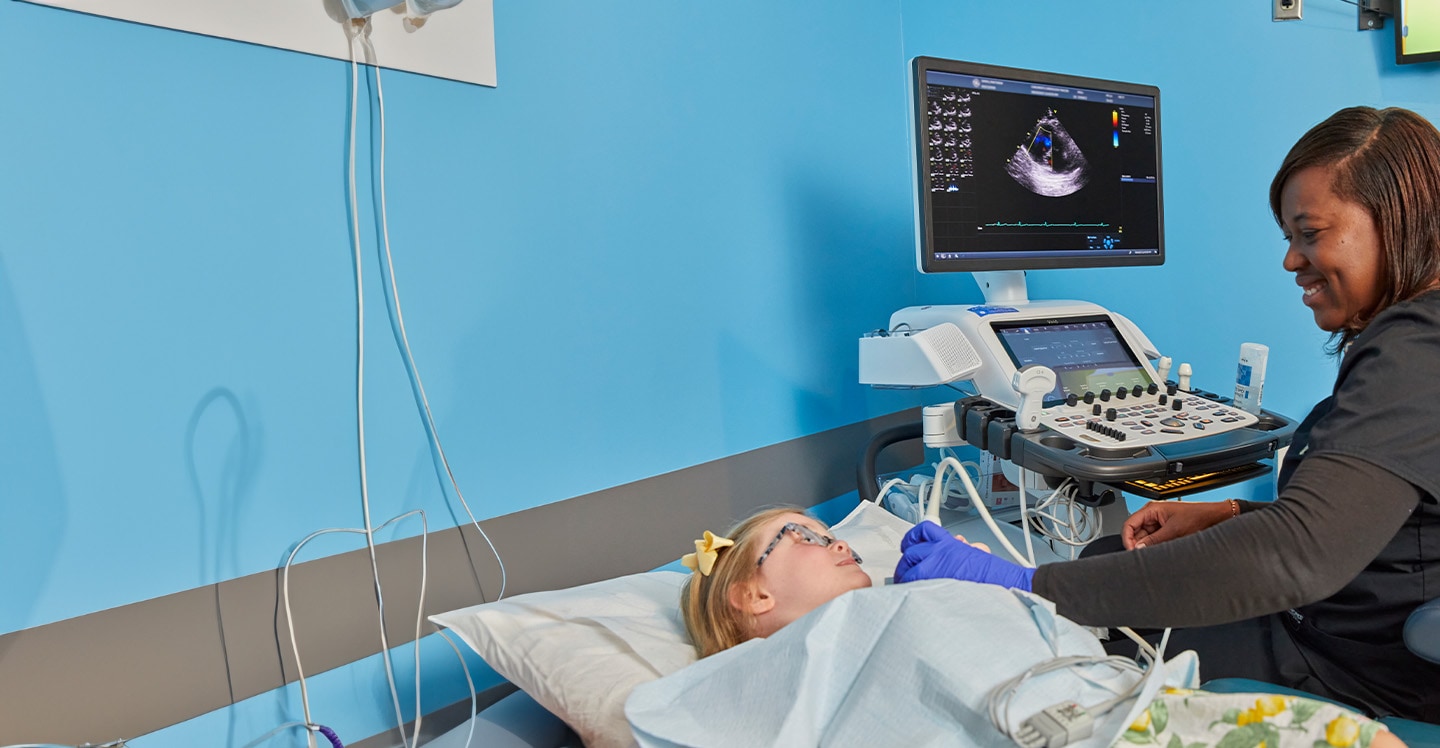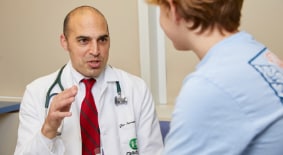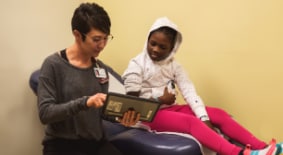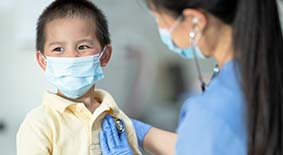The aorta and other blood vessels can be vulnerable to a variety of inherited and acquired conditions that can weaken the wall of the vessel or make them too large, too small or twisted. At the Children’s Heart Center, we bring together a team of pediatric cardiologists, cardiothoracic surgeons, advanced practice providers and genetic counselors who specialize in the diagnosis, treatment and management of conditions or diseases of the aorta, arteries, veins and blood vessels. The Children’s Aorta and Vascular Program offers close monitoring, medical management and educational support, as well as surgical and catheter-based treatments for conditions and diseases of the aorta and blood vessels, offering comprehensive cardiovascular care for patients from birth to age 21. We have providers dedicated to the clinic with expertise in medical genetics and advanced cardiac imaging, and work with other specialists to provide a team-based approach to your child’s care. As the largest program of its kind in the Southeast, we have cared for more than 6,500 patients with aorta and blood vessel conditions since the program’s inception in 2012.
Why Choose Children’s Aorta and Vascular Program?
- Expertise: Many of the physicians, nurse practitioners and genetic counselors in our program are leaders in their field and have been actively involved in the aortic disease medical community for the past 20 years. We are committed to helping families receive the best care for their children.
- Excellent surgical outcomes: As one of the top pediatric cardiology and heart surgery programs in the nation, our surgeons treat complex and simple conditions of the aorta, with excellent outcomes that surpass the national average.
- Comprehensive care: Many of the conditions that cause aortic disease may be associated with connective tissue disorders and we facilitate evaluation with other specialists as needed.
- Innovative research: We are actively involved in national and international research collaborations to improve current and future care for children with aortic conditions.
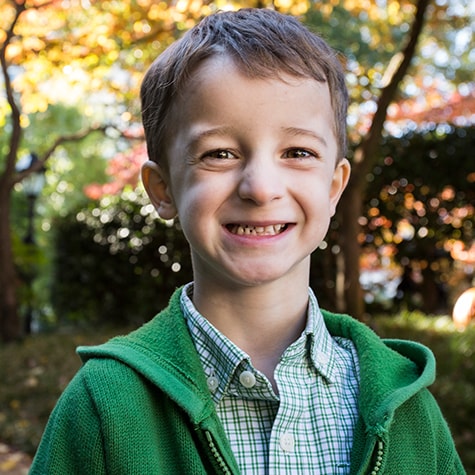
Two heart surgeries later, Hampton is thriving
When Hampton was a toddler, doctors discovered his health conditions had something in common: his heart. After two surgeries, he’s back to being a kid.
Read his storyMarfan Syndrome Program
The Marfan Syndrome Program at the Children’s Heart Center specializes in the diagnosis and treatment of cardiovascular conditions in infants, children and teens with Marfan syndrome.
learn moreWhat is the aorta?
The circulatory system is made up of a complex network of arteries, veins and blood vessels that carry oxygen and nutrient-rich blood from their heart to the body’s tissues and back again. The aorta is the largest artery in the body and arises from the left ventricle to supply all the other arteries in the body.
We offer a complete range of services to treat aortic and vascular conditions, from simple to complex, including:
- Alagille syndrome: An inherited disorder that affects the liver and bile ducts. It can affect a variety of other organs including the heart, causing pulmonary artery stenosis, heart murmurs and complex congenital heart defects.
- Aortic aneurysm: A bulge that develops in the wall of the aorta. While aortic aneurysms don’t typically have symptoms, a ruptured aortic aneurysm can cause severe bleeding and is a life-threatening emergency. Abdominal aortic aneurysms occur in the belly or abdomen area, and familial aortic aneurysms occur near the heart.
- Aortic dissection: A serious condition in which a tear occurs in the inner layer of the aorta, allowing blood to pass through the tear and push into the wall of the aorta dividing the middle layers. This condition requires emergent evaluation and surgical consultation.
- Aortic ectasia: Also known as aortic dilation, this is a condition condition in which the top part of the aorta, the ascending aorta, is wider than normal. It can result in other serious complications, such as aortic valve leakage, a condition in which blood flows back into the heart.
- Arterial tortuosity syndrome: A rare genetic connective tissue disorder that is characterized by lengthening and twisting or distortion of arteries throughout the body. Affected arteries can be prone to other complications such as developing aneurysms, tearing or narrowing.
- Bicuspid aortic valve (BAV): A heart condition in which an aortic valve contains only two flaps instead of three. This condition can be associated with valvar dysfunction (narrowing or leakage) and/or aortic dilatation that may require medical management or treatment.
- Aortic root dilation: Also known as an enlarged aortic root or an aortic root aneurysm, a dilated aortic root is when the section of the aorta that connects to the heart becomes enlarged.
- Loeys-Dietz syndrome: A connective tissue disorder that can affect a variety of body systems leading to aortic aneurysms, cleft palate, skeletal anomalies and tortuosity (twisting) of some of the arteries.
- Marfan syndrome: An inherited connective tissue disorder that can result in a variety of cardiovascular conditions such as aortic aneurysms and mitral valve prolapse.
- Noonan syndrome: An inherited condition that causes symptoms that affect a variety of body functions. It can result in a variety of congenital heart conditions, including pulmonary valve stenosis, hypertrophic cardiomyopathy, arrhythmia and narrowing of the aorta.
- Stickler syndrome: An inherited group of connective tissue disorders that can affect the musculoskeletal system, vision, and be associated with mitral valve prolapse.
- Turner syndrome: An inherited condition affecting females that results from the absence of all or part of one of the X chromosomes. This condition commonly affects growth and development and is associated with aortic disease.
- Vascular ring: A category of congenital abnormalities of the aorta and some of the larger arteries that causes the vessels to take an unusual course through the chest and encircle the airway or the esophagus or both. Symptoms associated with vascular rings may include difficulty breathing (stridor or wheezing) or difficulty swallowing.
- Vascular Ehlers-Danlos syndrome (vEDS): Vascular Ehlers-Danlos syndrome (vEDS): An inherited disorder that affects the connective tissues. This disorder can cause the walls of the blood vessels to be fragile and at risk for tear or rupture.
- Williams syndrome: A genetic condition that can affect many different parts of the body and can result in a narrowing of the aorta, as well pulmonary artery stenosis.
Because many of the conditions treated in the Children’s Aorta and Vascular Program are inherited, our program includes two genetic counselors who can facilitate pediatric genetic testing to confirm a diagnosis, as well as determine if screening of parents or siblings is warranted. Our pediatric cardiologists will work with genetic counselors to help patients understand their options, risks and the implications of their condition.
Once diagnosed, your child may undergo a variety of diagnostic cardiovascular imaging tests to help accurately guide treatment including:
- CT scan: Also known as a computed tomography scan, a CT scan uses X-ray technology to create cross-sectional, detailed images of your child’s heart and blood vessels.
- Cardiac MRI: Also known as magnetic resonance imaging, an MRI is an imaging test that uses a large magnet, radio waves and a computer to take high-quality pictures of your child’s heart and blood vessels.
- Echocardiogram: A test that uses sound waves to create a detailed picture of the heart and blood vessels.
Medical and Nonsurgical Treatment
Our specialized team is dedicated to minimizing the impact of aorta and vascular conditions on the long-term health of our patients. We strive to educate patients and families, and we offer longer appointment times to help ensure families have all of their questions answered about their child's care. We offer a variety of nonsurgical treatments to manage aortic and vascular conditions, including surveillance and medical therapies. In many cases, patients may not need to have aortic surgery or other vascular interventions during their childhood.
Pediatric Aorta Surgery
If your child, teen or young adult needs surgery for an aorta condition, our doctors are on the forefront of aortic surgery innovations.
As one of the highest-volume congenital heart surgery programs in the country, our surgeons and post-operative care team in the cardiac intensive care unit (CICU) have the experience and resources to support your child through their surgery and recovery.
We offer a variety of pediatric-specialized surgical procedures for complex aortic and vascular conditions, including:
- Aortic repair: Aortic repair is a procedure used to treat pediatric aortic aneurysms in which the surgeon removes the aneurysm and places a graft in the affected area.
- Valve-sparing aortic root replacement: A heart surgery that removes an aneurysm by removing the damaged aortic root and replacing it with an artificial graft that surrounds the aortic valve.
- Aortic valve replacement: Pediatric aortic valve replacement is a heart surgery in which the surgeon removes the diseased valve and replaces it with an artificial aortic valve or a valve from a donor.
- Balloon aortic valvuloplasty: A minimally invasive procedure in which a balloon is guided by a thin wire, called a catheter, to the narrowed aortic valve. The balloon is then inflated, which widens the aortic valve and can relieve aortic valve narrowing.
- Ross procedure: The Ross procedure in pediatric patients replaces a narrowed or leaky aortic valve. First, the surgeon takes out the defective aortic valve and replaces it with the child’s pulmonary valve. The new aortic valve allows the left ventricle to pump oxygen-rich blood to the body. The pulmonary valve is then replaced with a pulmonary valve from a donor, which allows oxygen-poor blood to flow from the right ventricle into the pulmonary artery to the lungs.
- Ross-Konno procedure: An open heart surgical procedure to repair an aortic valve, this procedure involves relieving left ventricular outflow tract obstruction and replacing a damaged aortic valve with the patient’s own pulmonary valve. The pulmonary valve is then replaced with a pulmonary valve from a deceased donor.
Our Aorta Surgery Outcomes
We monitor our aorta and vascular surgical outcomes and make them available so parents have the most accurate information available as they choose the best hospital for their child’s surgery. Children's data (below) shows the number of benchmark procedures performed and their survival rates compared to the national average from January 2021 to December 2024.
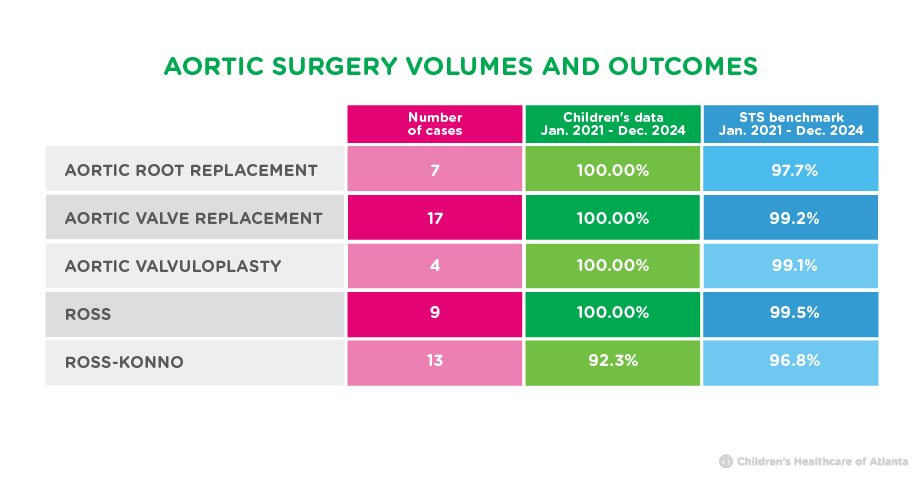
Long-Term Care for Aorta and Vascular Conditions
Relationships are long-lasting at the Children’s Heart Center, since some aortic and vascular disorders can be detected at birth and our team follows children until they turn 21. When patients age out of our program, we help transition them to adult providers who can treat their particular issues.
Pediatric Cardiology Providers
Pediatric Cardiothoracic Surgeons
- Paul Chai, MD, Chief, Cardiothoracic Surgery; Co-Chief, Heart Center
- Subhadra Shashidharan, MD, Associate Chief, Cardiothoracic Surgery
- Joshua Rosenblum, MD, PhD
- Fawwaz Shaw, MD
- Mohan John, MD
Pediatric Genetic Counselors
- Erin Demo, MS, CGC
- Linda Knight, MS, CGC
Outpatient Pediatric Cardiology Locations
Children’s Cardiology sees patients at more than 20 outpatient locations throughout Georgia.
Find an Outpatient Cardiology Clinic >
Call 404-246-2593 or Schedule an appointment >
Cardiothoracic Surgery Location
Arthur M. Blank Hospital
2220 North Druid Hills Road NE
Atlanta, GA 30329
Call 404-785-6330 to schedule an appointment.
Contact Us 404-256-2593
